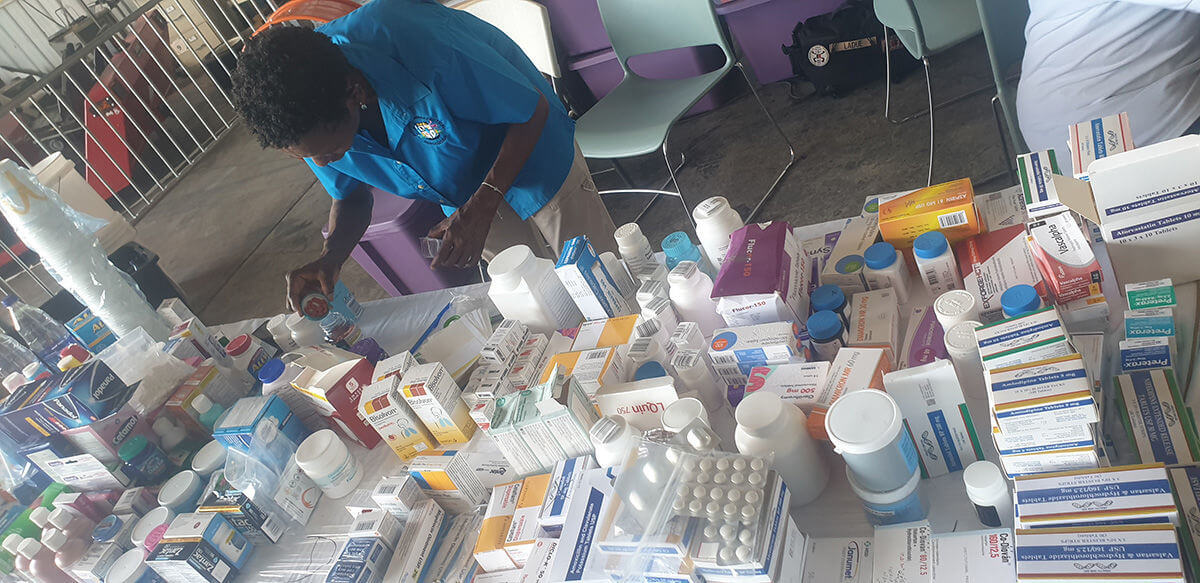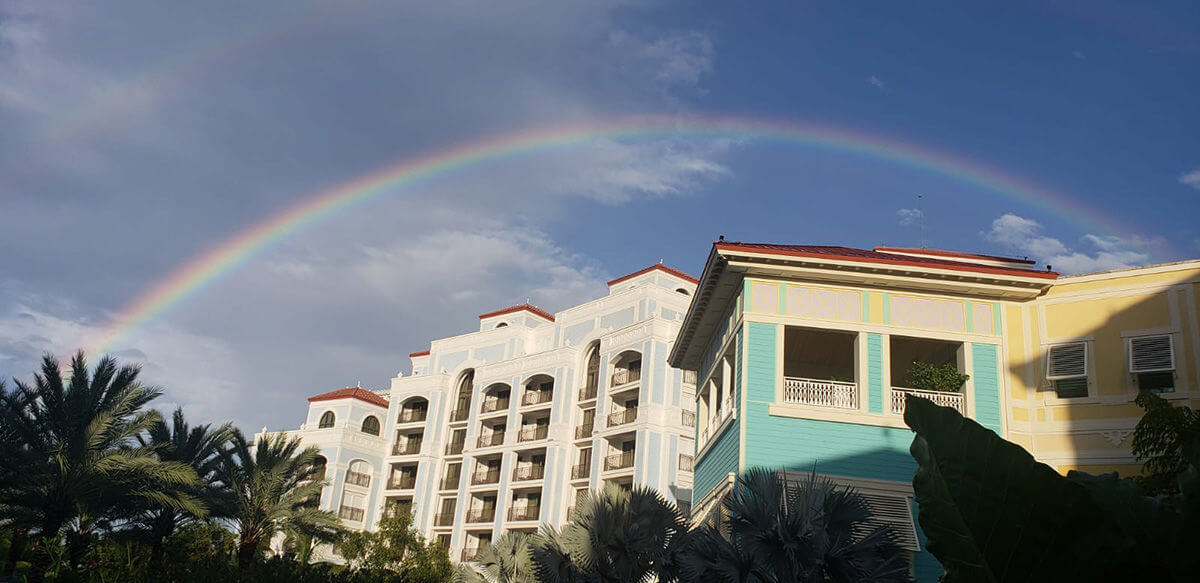 Courtesy photos
Courtesy photos
The water continued to rise as the rain pounded Marsh Harbor, a town on Abaco, one of the 700 islands of the Bahamas archipelago. Hurricane Dorian plodded along, slowing almost to a stop directly over the island’s meager homes. Rain and wind lashed the wood and aluminum dwellings, but the real threat came from the sea. Changes in climate meant that, even before the storm, the ocean was higher than it was only a few years ago, and Dorian left nearly 60 percent of the island under water.
I was there with Americares, a humanitarian organization I had worked with in Haiti after Hurricane Matthew and in Panama City after Hurricane Michael. We were a medical team ready with medications and supplies and the Ministry of Health asked us to give care to all the evacuees who were living in the gymnasiums, community centers and churches of Nassau.
Many people in the shelters — nearly all evacuated from Marsh Harbor — described horrifying stories of water rising rapidly and sucking people out with it. The shelters in the capital were filled almost exclusively with Haitian immigrants and Haitian Bahamians.

“I ran out of my house and got hit in the back from falling debris. I ran to the church but it later collapsed. I ran to the school and then it collapsed. Now I’m lucky to be here. I lost many friends. Too many to count. There are still many bodies under the blocks, and many washed out to sea.” —Middle-aged single man with back pain
Building codes in the Bahamas require all structures to be able to withstand a Category 4 hurricane. Dorian came pounding in as a Category 5. When we met with the health minister, he reported that the government was struggling with what standard to build to now. Buildings that offer protection against Category 5 hurricanes will take longer to construct and cost significantly more. For a middle-income country with a small economy, the dilemma has no easy solution, though they unequivocally plan to rebuild Abaco and elsewhere.
“My back hurts, mostly around my lower ribs.”
I push on the 11th and 12th ribs. He is tender on both sides. Most people with back pain in these situations have been struck by debris during the storm or the clean-up. Not this man. “I was born in the Bahamas to parents from Haiti, but my wife is a Haitian immigrant. She doesn’t know how to swim. So as the water rose we floated out of the house, and I had to put her on my back. For two hours I swam with her on my back. She couldn’t let go.”
I write, “swimming while saving spouse’s life” in the chart as the cause of back pain. I give him ibuprofen, same as if he had hurt it during work or experienced other routine soreness. But this man carries a pain of loss and a quiet joy, born of exhaustion and survival against Mother Nature. “She doesn’t have her passport or any other documents now. I guess we’ll have to go wait in line at the Haitian embassy.”
The true death toll will never be known. The shantytowns where the poor lived were completely washed away and the true population, including the many undocumented Haitian immigrants, was not known prior to the storm. The official death toll, if ever actually performed, would be woefully inaccurate because many were simply washed out to sea. Families may not register a missing person who wasn’t supposed to be there in the first place. Single men who came seeking work may have no family to report them missing. Entire families could have washed away with no evidence of their existence or of their demise. The Bahamian government has an interest in a lower death toll to minimize criticism of their immigration policies or the enforcement of building codes in the shantytowns.
“We have lived here for 20 years and now we’ve lost everything. Our son is in Haiti. We’re going to go back. We have nothing to rebuild with.” —Elderly couple who social workers helped buy a one-way ticket back home to Haiti
Two patients that I referred to the ER were both turned away after waiting for hours, with no testing having been done. Neither spoke effective English but the forms I sent clearly detailed the reason for referral. Discrimination lives everywhere, and poor immigrants who don’t speak the language are easy targets. Many Haitian immigrants are afraid to seek treatment at public hospitals for fear of deportation. The Bahamian government has explicitly stated that nobody seeking medical care after the storm needs to fear deportation. The government also suspended user fees at public hospitals. I made a point to ask all the people I spoke to in the shelter what their life was like before. All the men were employed, usually in manual labor jobs, and many of the women were as well. Their employment in the Bahamas demonstrated the need for their labor, which provided a huge upgrade in their living standards from Haiti, where they could find few, if any, jobs.

“My friend left the house in the middle of the storm. He slid along the wall of the house until the corner and then disappeared. He may be up in the sky or down underground. Or under the water. I saw more than 30 bodies after the storm, but none were his.” —Middle aged man outside the shelter
The hurricane response by the Bahamian government was slow to develop, but by eight days after the storm, it appeared like a well-oiled machine. At the Nassau airport, authorities had set up food provided by World Central Kitchen and Chef Jose Andres, medical care provided by Americares and others, and social workers to register and classify people according to their housing status. Those with family wore one color bracelet and those who needed semi-permanent shelter wore another. At the shelters, doctors and nurses from the public health system rotated through. Nonprofits like Americares assisted with extra staff, medication and supplies. This was the fifth post-disaster relief effort that I have participated in, and perhaps the most well-organized.
“I’m coming to Bahamas in 1963. I’m coming in Bahamas, I’m young woman. I’m coming to Nassau, I’m old woman. I got passport in Port-au-Prince in 1963. Then Bahamas passport. Now that is gone, too. Big water took it.” —Elderly woman in a shelter
The Bahamians in Nassau were eager to help. Doctors and nurses from the private sector donated their time at shelters. Pharmacies donated medications. Restaurants donated food. A few random strangers who saw that I was buying medications and supplies decided to purchase the goods for us and called other friends who might have been able to offer further help.
“I hid my grandson on top of a cabinet. I knocked on God’s door as I saw the water rising in the house. He eventually took my husband. He took my two daughters under the water. But I prayed and prayed, and he left me with this boy.” —Grandmother holding her only living relative, a three-year old grandson.
What can we do in the face of overwhelming tragedy? Donate money to charities involved in providing care. Hold food and clothing drives at your school and church. All good and helpful things.
But this will happen again and sometime soon. Think about the victims of these storms the next time you fill up your SUV with gas or lower your thermostat to 68 degrees or eat red meat every day. The climate will continue to pound us with massive hurricanes and the poorest among us will always pay a higher price.
“We went to the attic but the water was still up to our necks. My children clung to the roof while I swam in place for two days. I still dream I’m in the water.” —Mother of two young children
Vincent DeGennaro is an internal medicine doctor and global public health specialist in the Florida International University College of Medicine. He works mostly in Haiti with the nonprofit Innovating Health International. See his An American Doctor in Haiti blog.